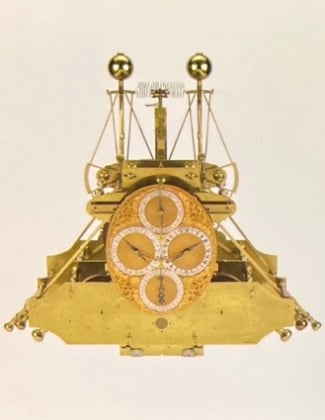British Watchmaking Origins
In the early 1700s, sailors used dead reckoning and celestial
navigation to cross the seas. They were also used to being wrong: such techniques were fraught with inaccuracies and miscalculations, and determining longitude – a ship’s east-west position – was the most vexing challenge of all.
By 1714, the loss of life at sea was so great that a King’s Ransom was
offered to determine longitude on board ships. The British government
passed the Longitude Act of 1714, promising a prize of up to £20,000
(equivalent to millions of pounds today) to anyone who could devise a
method for determining longitude to within half a degree. It was widely
assumed that celestial charts and complex mathematics would provide
the answer if one were to be found at all.
The problem was widely viewed as one of astronomical and scientific calculation rather than mechanical engineering.

Astronomical Map of the Northern and Southern Hemispheres

John Harrison, a man of humble origins and with no formal training in horology, was convinced he could solve the issue. Born in 1693 in the small Yorkshire village of Foulby, Harrison was a carpenter’s son who, having learnt his father’s trade, taught himself clock making.
Harrison’s work on perfecting the Marine Chronometer shaped the world as we know it today, saving countless lives at sea, allowing trade and improving the standard of living globally. His many horological innovations facilitated the birth of the pocket watch and then the wristwatch, the ultimate portable timepiece.
The clock he developed and took with him aboard the HMS Centurion from Portsmouth to Lisbon, today known as ‘H1’, took him five years to make. As a design and as a functional proof of concept, it was nothing short of astonishing, it worked! This started Harrison on a life-long quest to perfect the Marine Chronometer. Indeed, the journey from H1’s proof of concept to the triumph of H4 remains one of the greatest stories in the history of science and technology, with an impact that continues to resonate.

H1 Clock, 1736

H2 Clock, 1741

H3 Clock, 1760

H4 Clock, 1762
It helped shape how we understand and measure time today and laid the groundwork for an age of vast transformations. The advent of marine chronometers made sea travel safer and more predictable, allowing for better trade routes, economic growth and colonial expansion. In tandem with the scientific and industrial advancements of the era, Harrison’s horological development helped propel the world into a new technological age.
The H1 stands as the origin point for modern timekeeping. In that moment, John Harrison set horology on a course that would ultimately lead timekeeping onto the wrist, and to the innovations and artistry of modern horology. It is in his footsteps that today’s finest watchmakers continue to follow.
Find out more about the Pragnell Bray Origins Clock - an ambitious tribute to the achievements of this British horologist, who profoundly influenced the course of history.
Watch CLP Page
Contact us